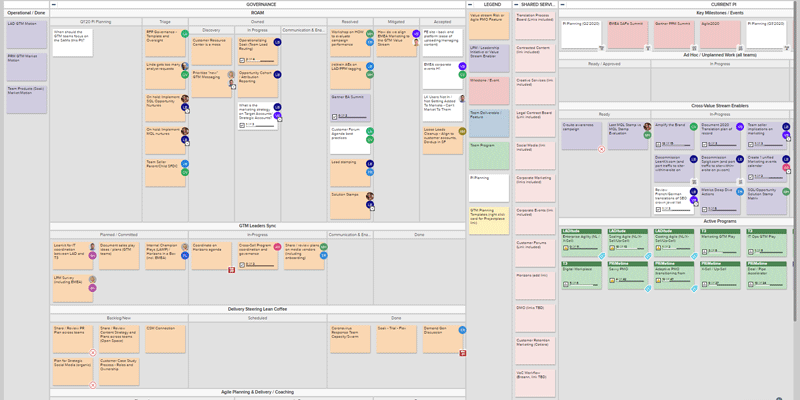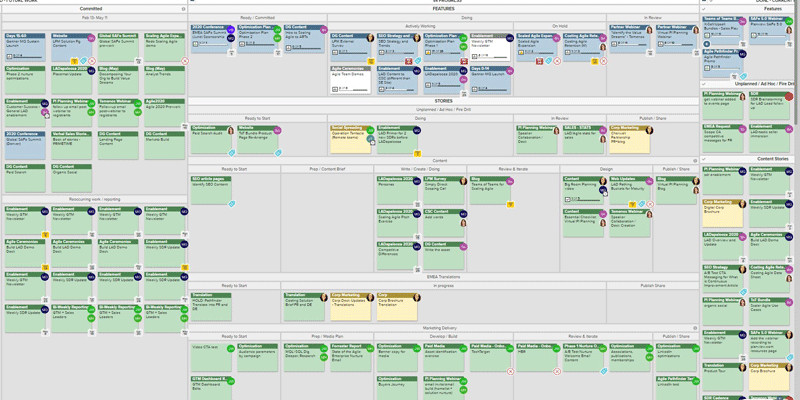 Just like many of you, we at Planview are trying to figure out how to do PI Planning in a world that doesn’t allow in-person interactions right now. While I understand the idea of doing virtual PI Planning is daunting, I don’t think the answer is to stop planning together. From my viewpoint, planning together is more important now than ever.
Just like many of you, we at Planview are trying to figure out how to do PI Planning in a world that doesn’t allow in-person interactions right now. While I understand the idea of doing virtual PI Planning is daunting, I don’t think the answer is to stop planning together. From my viewpoint, planning together is more important now than ever.
As we figure out what our agenda looks like, we’re taking into account the fact that people will be comfy and cozy, sitting in their homes, so this had better be engaging, or we’re going to lose people to distraction real fast. I thought I’d share some tips and tricks we’re planning to implement at our virtual PI Planning in a few short weeks.
What’s below is not exhaustive to all the things we’re doing (sign up for the webinar: How to do PI planning for that deep dive), but they are thoughts and ideas we had that might get your own thoughts and ideas flowing.
Pre-Planning for Virtual PI Planning
I don’t think many of you would argue with me when I say pre-planning for PI Planning is super important and it’s just as important as we try virtual PI Planning for the first time. Be sure leadership is on the same page.
- What are the highest priority epics and features the teams need to work on? This can be accomplished through Portfolio Kanban.

- What is the context that must be shared with the teams so they understand how their work connects to the broader business goals and outcomes?
- Are there changes to the teams and/or budget discussions that need to be had prior to PI Planning?
- What’s the best agenda to keep everyone engaged? Think outside-the-box here.
- Use a tool like Planview AgilePlace to build virtual whiteboards, with a backlog, “stickies”/cards, and iterations.

If you’ve done in-person PI Planning before, none of these are new to you, but in the current environment, I think it’s worth taking a step back and getting back to basics.
During Virtual PI Planning
Instead of being physically face-to-face, you’re all going to be face-to-face in 2D on some virtual meeting platform. Make the most of it:
- Respect the timebox. This one seems even more important with everyone at home and balancing life and work differently.
- Make context short, sweet, and to the point. Have those delivering this information stick to top three things and no more than five slides.
- Consider suggesting a group exercise before the start of sections. Get the blood flowing with planks, lunges, squats or jumping jacks. Get creative.
- You may need to recruit some people outside of the ART or teams of teams to help facilitate team breakouts. If your Scrum Masters are up for it, coach them, but if they are also part of building the plan, then consider someone else so the Scrum Master can be fully present to building the plan.
- Close out the session with clear guidelines for next steps. What do you want the teams to accomplish in week one?
Post-Virtual PI Planning
Provide the teams with the support they need. Some teams are used to working fully remote (as is our entire LeanKit development team), but other teams are used to being co-located and discussing the plan outside of ceremonies. Encourage teams to re-think/re-look at their ceremonies.
- Provide team leaders (Product Owners and Scrum Masters) with continuing education and give them the space to learn. If you don’t have a Community of Practice (CoP) or Guild already set up for various Agile leaders, considering doing so.
- Consider a little extra time at the beginning of each week’s stand-up to spend a few minutes discussing the business goals and objectives the work is aligned to.
- It could be worth implementing Lean Coffee regularly with key leaders for team members to ask questions.
Clearly, this isn’t an exhaustive list, but I hope it’s provided you with a few things you hadn’t considered when trying to pull together a virtual PI Planning event. In addition, we want to help our Agile Coaches and Transformation Consultants navigate this change. If you’re on the hunt for an easy-to-use solution to help guide your virtual PI Planning (or in-person when we get back to it), please reach out to Jon Terry directly (jterry@planview.com) to receive a free license of LeanKit. We’re all in this together, so feel free to share additional ideas and/or tips and tricks as you do virtual PI Planning.






